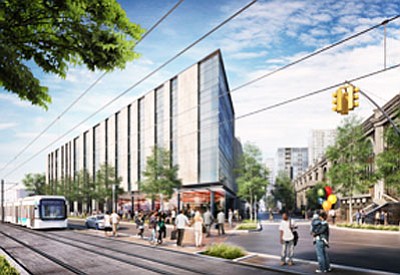BALTIMORE — When you walk through Historic Marble Hill, you will appreciate the architectural craftsmanship with details that have stood the test of time and can’t be replicated by today’s builders. From our Italianate-inspired high ceilings and masterful brickwork to our white marble steps, Marble Hill demonstrates why Baltimore is called “Charm City.”
In spite of its charm, Marble Hill and the surrounding communities are in dire need of redevelopment and revitalization. The health statistics for Marble Hill and the surrounding communities are among the worst in the City even though our boundary begins two blocks from State Center. One reason is the absence of a quality supermarket with fresh wholesome food. Through recent efforts of our City Council, the Department of Recreation and Parks, Parks & People Foundation, and the Department of Transportation, our community has had a bit of a face-lift. Our park has been transformed and landscaped, our broken sidewalks have been replaced and trees have been planted. The community’s image has improved a tiny bit, but the deep problems that resulted from decades of redlining and neglect remain. We are deeply grateful to our City Council for their efforts to persuade our Governor to allow the State Center redevelopment project to proceed.
Nevertheless, in the 38 years that I have lived in Marble Hill, residents have never had real access to capital, economic parity or sufficient resources for the community to thrive. Marble Hill and the surrounding communities need the infusion of investment that would stimulate interest and attract new residents. We have witnessed the transformation of Bolton Hill, Canton, Federal Hill and Hampden-Remington and even the Rotunda. We know that a major project like the development of State Center would be the perfect catalyst to set this section of Charm City on the path toward a bright future.
If completed, State Center’s sprawling campus would offer 2,000 new affordable housing units, an accessible supermarket, retail stores and commercial space for dozens of new businesses. This configuration of the space would facilitate the creation of thousands of new jobs. All of this would be in addition to the new, state-of-the-art office complex to accommodate the State Departments and the 3,000 state employees who work there. Baltimore City needs to keep these jobs right here. The community needs to have this project right here.
This project would be privately funded. It would generate property taxes to support Baltimore City Schools, and I think it would solve two problems. First, property tax income would solve some of the budget shortfall and second, school enrollment would increase as new families move into the area. The community met at least 145 times over 10 years until the State Center development project offered what residents need. We look forward to the implementation of both the Community Benefits Agreement whereby the developer would contribute $1 million to the State Center Neighborhood Alliance for community uses, and the economic inclusion plan that prioritized local hiring, participation of women and minority contractors, and job training. It seems that our hopes and aspirations will be disregarded again while Port Covington and Harbor East enjoy tax-funded enhancements.
We owe it to ourselves to persevere toward a future that includes renewal, reinvestment and revitalization for the communities of Central West Baltimore, which have been neglected for decades. If not now, when?
Dr. Steva A. Komeh-Nkrumah is a former president of the Marble Hill Community Association— a member of the State Center Neighborhood Alliance
